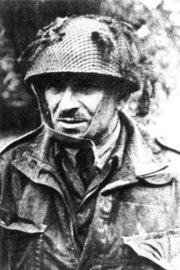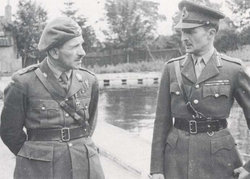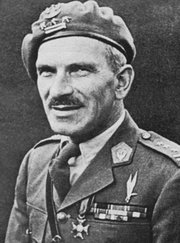Stanislaw Sosabowski
|
|
Template:Infobox Biography Maj.Gen. Stanisław Franciszek Sosabowski (1892 - 1967) was a Polish general in World War II. He fought in the Battle of Arnhem (Netherlands) in 1944 as commander of the Polish 1st Independent Parachute Brigade.
| Contents |
Biography
Early years
Stanisław Sosabowski was born on May 8, 1892, in Stanisławów, in a railway workers' family. He graduated from a local gymnasium and in 1910 he was accepted as a student of the faculty of economy of the University of Kraków. However, the death of his father and poor economical situation of his family forced him to abandon the studies and return to Stanisławów. There he became a member of Drużyny Strzeleckie, a semi-clandestine Polish national scouting organisation. He was soon promoted to the head of all Polish scouting groups in the area.
World War I
In 1913 Sosabowski was drafted into the Austro-Hungarian Army. After the training he was promoted to the rank of corporal of the 58th Infantry Regiment. After the outbreak of World War I he fought with his unit against the forces of Imperial Russia in the battles of Rzeszów, Dukla Pass and Gorlice. For his bravery he was awarded with several medals and promoted to First Lieutenant. In 1915 he was heavily wounded in action and withdrawn from the front.
In November 1918, after Poland regained its independence Sosabowski volunteered for the newly-formed Polish Army, but his wounds were still not cured and he was rejected as a front-line officer. Instead, he became a staff officer in the Ministry of War Affairs in Warsaw.
Inter-war years
After the Polish-Bolshevik War Sosabowski was promoted to Major and in 1922 he started his studies at the Higher Military School in Warsaw. After he finished his studies he was assigned to the Polish General Staff. Promoted to Lieutenant Colonel, in 1928 he was finally assigned to a front-line unit, the 75th Infantry Regiment, as commanding officer of a battalion. The following year he was assigned to the 3rd Podhale Rifles Regiment as its deputy commander. From 1930 he was also a professor of logistics at his alma mater.
In 1937 Sosabowski was promoted to colonel and became the commanding officer of the 9th Polish Legions Infantry Regiment stationed in Zamość. In January 1939 he became the commander of the prestigious Warsaw-based 21st "Children of Warsaw" Infantry Regiment.
Polish Defence War
According to the Polish mobilisation scheme, Sosabowski's regiment was attached to the 8th Infantry Division under col. Tadeusz Wyrwa-Furgalski. Shortly before the Polish Defence War started his unit was moved from its garrison in the Warsaw Citadel to the area of Ciechanów, where it was planned as a strategic reserve of the Modlin Army.
On September 2 the division was moved towards Mława and in the early morning of the following day it entered combat in the Battle of Mława. Although the 21st Regiment managed to capture Przasnysz and its secondary objectives, the rest of the division was surrounded by the Wehrmacht and destroyed. After that Sosabowski ordered his troops to retreat towards Warsaw.
On September 8 Sosabowski's unit reached the Modlin Fortress. The routed 8th Division was being reconstructed, but the 21st Regiment was attached to the corps led by general Juliusz Zulauf. After several days of defensive fights, the corps was moved to Warsaw, where it arrived on September 15.
Instantly upon arrival, Sosabowski was ordered to man the Grochów defensive area and defend Praga, the eastern borough of Warsaw, against the German 10th Infantry Division. During the Siege of Warsaw the forces of Sosabowski were outmanned and outgunned, but managed to hold all their objectives. When the general assault on Praga started on September 16, the 21st Infantry Regiment managed to repulse the attacks of German 23rd Infantry Regiment and then successfully counter-attacked and destroyed the enemy unit.
After this success, Sosabowski was assigned to command all Polish troops fighting in the area of Grochów. Despite constant bombardment and German attacks repeated every day, Sosabowski managed to hold his objectives at relatively low cost in manpower. On September 26, 1939, the forces led by Sosabowski bloodily repulsed the last German attack, but the following day Warsaw capitulated. On September 29, shortly before the Polish forces left Warsaw for German captivity, general Juliusz Rómmel awarded col. Sosabowski and the whole 21st Infantry Regiment with the Virtuti Militari medal.
France
Following the Polish surrender, Sosabowski was a prisoner of war, and was interred at a camp near Zyrardow. However, he escaped and remained in Warsaw under a false name, where he joined the Polish resistance. He was ordered to leave Poland and reach France with important reports on the situation in occupied Poland. After a long trip through Hungary and Romania he arrived in Paris, where the Polish government in exile assigned him to the Polish 4th Infantry Division as the commanding officer of infantry.
Initially the French authorities were very reluctant to hand the badly-needed equipment and armament for the Polish unit. The soldiers of Sosabowski had to train with pre-WWI weapons. In April 1940 the division was moved to a training camp in Parthenay and was finally handed the weapons that were awaited since January, but it was already too late to organise the division. Out of more than 11 000 soldiers only 3 150 were given arms. Knowing this, the commander of the division general Rudolf Dreszer ordered his unit to withdraw towards the Atlantic coast. On June 19, 1940, Sosabowski with approximately 6 000 Polish soldiers arrived to La Pallice, from where they were evacuated to Great Britain.
Great Britain
Upon his arrival to London, Sosabowski turned up in the Polish General Staff and was assigned to 4th Rifles Brigade that was to became a core of the future 4th Infantry Division. The unit was to be composed mainly from Canadian Polonia, but it soon became apparent that there is not enough young Poles in Canada to create a division out of them,
Then Sosabowski decided to transform his brigade into a Parachute Brigade, the first such unit in the Polish Army. The volunteers come from all the formations of the Polish Army. In Largo House a training cam was built and the parachute training was started. Sosabowski himself passed the training and, at 49 years of age, made his first parachute jumps. According to relations of Sosabowski's former subordinates, the colonel was strict yet just commander. Impulsive and harsh, Sosabowski could not stand any opposition. This made the creation of a Polish parachute brigade possible, but also made contacts with his superiors problematic.
In October 1942 the brigade was ready for combat and was named the 1st Independent Parachute Brigade. Since the Polish General Staff planned to use the brigade to aid the all-national uprising in Poland, the soldiers of the 1st Polish Para were to be the first element of the Polish Army in Exile to reach their homeland. Hence the unofficial motto of the unit: the shortest way (najkrótszą drogą).
In September 1943 Lt. Gen. Frederick Browning proposed that Sosabowski reform his unit into a division and fill the remaining posts with Englishmen. Sosabowski himself would be assigned to the newly-formed division and promoted to general. However, Sosabowski refused. However, on June 15, 1944 he was nevertheless promoted to gen.bryg..

Warsaw Uprising
In early August 1944, news of the Warsaw Uprising arrived in Great Britain. The brigade was ready to be paradropped into Warsaw to aid their colleagues from the Home Army, who were fighting a desperate battle against overwhelming odds. However, the British staff decided that the risk of transporting the brigade to Warsaw would be too high. The morale of the Polish troops suffered badly, and many of the units verged on mutiny. The British staff threatened its Polish counterpart with disarmament of the brigade, but Sosabowski retained control of his unit. Finally, Polish Commander in Chief Kazimierz Sosnkowski put the brigade under British command, and the plans to send it to Warsaw were abandoned. It was not until after the war that general Sosabowski learnt that his son, Stanisław "Stasinek" Sosabowski, a medic and member of the Kedyw, had lost his sight during the uprising.
Battle of Arnhem
The Polish 1st Independent Parachute Brigade was included in the Allied forces taking part in Operation Market Garden. Due to poor weather and lack of planning, the brigade was split into several parts before entering the battle. A small part of the brigade with Sosabowski was dropped near Driel on September 19, but it was not until September 21 when the rest of the brigade finally arrived in the distant town of Grave, falling directly into the waiting guns of the Germans camped out around the area. The Brigade's artillery was dropped together with the British 1st Airborne Division and the howitzers were to arrive by sea transport. This prevented the Polish forces from being used effectively. Three times Poles under Sosabowski tried to force the Rhine crossing in order to help the surrounded 1st Airborne. However, the ferry they planned to use to reach the British had been sunk and Poles attempted the river crossing in small rubber boats under heavy fire. Nevertheless, at least 200 men succeeding in crossing and reinforcing the embattled British.
Despite the difficult situation on the front, during a September 24 staff meeting, Sosabowski suggested that the battle could have still been won. He suggested that the combined forces of 30th Corps and the Polish Brigade should start an all-out assault on the German positions and try to break through the Rhine. This plan was not accepted, and during the last phase of the battle, on September 25 and 26th, Sosabowski led his men southwards and shielded the retreat of remnants of the 1st Airborne. The rate of casualties among the Polish units that fought in the battle was high, in some cases as high as 40%.
After the battle Sosabowski was unjustly made a scapegoat for the failure of Operation Market Garden, following a critical evaluation by English Lt. Gen. Frederick Browning. He was accused of criticizing Field Marshal Montgomery and the Polish General Staff was forced to remove him as the commanding officer of his brigade on 27 December 1944. He was made the commander of guard troops and in July 1948 he was demobilised.
After the war
Shortly after the war Sosabowski managed to bring his only son and his wife from Poland. Soon afterwards, in September 1946 the communist Soviet-backed authorities in Poland deprived Sosabowski of Polish citizenship. Stanisław Sosabowski had no choice but to remain in exile. He died in London on September 25, 1967. In 1969 his remains were interred in the Powązki cemetery in Warsaw, Poland.
Awards
He was awarded many military honours, including:
- Virtuti Militari
- Order of Polonia Restituta
- Cross of Independence
- Polish Cross of Valour
- Commander of the Order of the British Empire
See also
References
External Links
- A Biography (http://www.sosabowski.com/generalcv.html)
- Sosabowski during Operation Market Garden (http://www.extraplan.demon.co.uk/stanislaw_sosabowski.htm)de:Stanisław Sosabowski
nl:Stanislaw Sosabowski pl:Stanisław Sosabowski sl:Stanislaw Sosabowski


